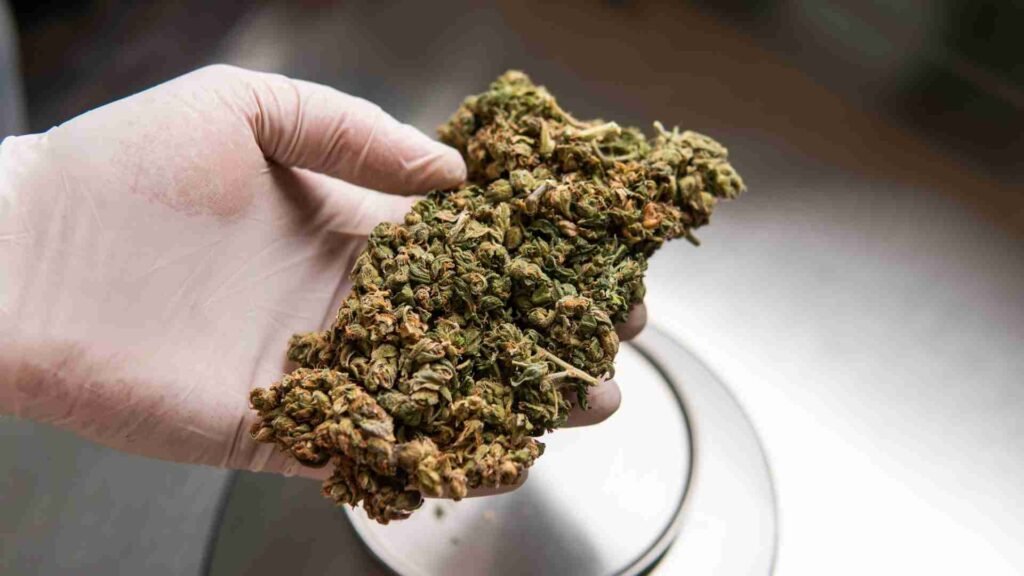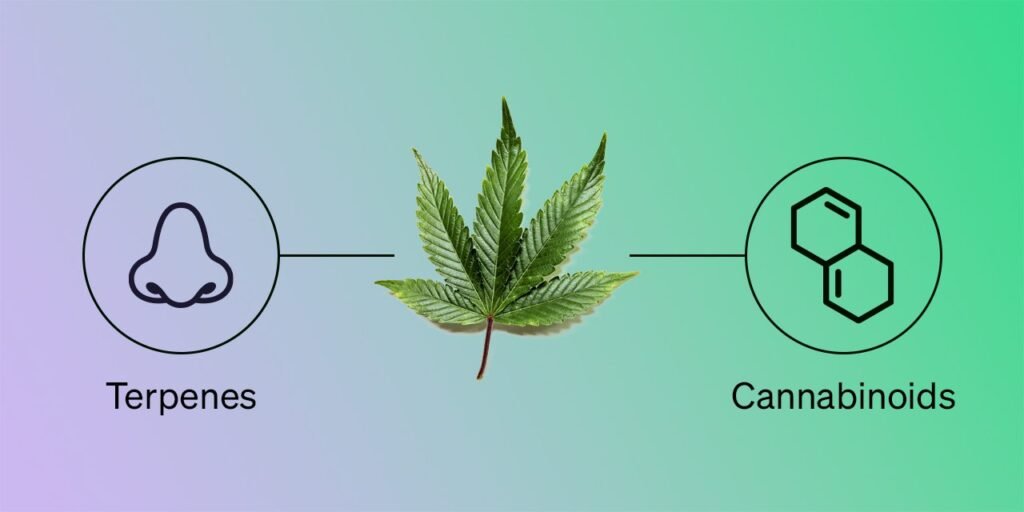The Role of Terpenes in Cannabis: Understanding Aromas and Effects
Cannabis is a complex plant with many different components that work together to produce certain effects. The two most well-known compounds in the plant, THC and CBD, are what give marijuana its psychoactive and therapeutic effects. Terpenes, on the other hand, belong to a separate family of chemicals and are essential to the cannabis plant’s overall production. Plants’ particular tastes and perfumes are caused by a group of chemical molecules known as terpenes. They are found in many other plants besides cannabis, including citrus fruits, lavender, and pine trees.
Cannabis’ unique effects on the body and mind are the result of the interaction between terpenes and cannabinoids like THC. We’ll look at the role of terpenes in cannabis and how they affect its potential as a recreational drug and an herbal cure.
What are Terpenes?
These are chemical compounds that are found in many different plants, including DC cannabis, in their natural state. They are in charge of providing many plants with their powerful scents and fragrances, including lavender, citrus fruits, and pine trees.
In cannabis plants, terpenes play a crucial role in determining each strain’s unique scent and taste profile. These are produced in the trichomes of cannabis plants alongside other essential compounds like cannabinoids.
They are produced by the biosynthesis process, in which simpler beginning molecules are transformed into more complex terpenoids by enzymes. More than 100 different terpene varieties exist in cannabis, each with a distinct chemical structure and aroma.
Examples of common terpenes found in cannabis
Terpenes like limonene, myrcene, pinene, linalool, caryophyllene, and humulene are frequently found in cannabis. Citrus fruits generally contain limonene, which has a lemony scent. It is well-known for boosting mood and energy levels.
Myrcene has an earthy scent similar to cloves or musk and is often credited with promoting relaxation and sedation. Pinene has a noticeable pine scent that can evoke images of fresh forests or Christmas trees. It is believed to offer anti-inflammatory benefits as well as improve memory retention.
Linalool has floral notes reminiscent of lavender flowers; they may have calming effects on the mind and body.
Caryophyllene gives off spicy aromas like black pepper or cinnamon; it’s been linked to potential anti-inflammatory properties and pain relief.
Humulene also has earthy smells but may have appetite-suppressing abilities while offering potential antifungal properties!
These examples represent just some of the many terpene profiles available to consumers looking for specific effects from their chosen strain. Understanding terpenes is critical to experiencing the full effects of cannabis strains, which is why they are such an important topic to explore.
Aromas and Flavors: Understanding the Impact of Terpenes on Cannabis
You smell more than one thing when you inhale a cannabis strain. Terpenes are a group of compounds that give each strain of marijuana its own distinct scent. These are present in everything from lemons to lavender, are what give plants their fragrant components.
Cannabis has more than 100 different kinds of terpenes, each with a unique scent. These are responsible for the flavor profile of cannabis strains in addition to the fragrance profile. Some of them have sweet or fruity notes, while others have more earthy or spicy tones. When combined, different terpenes can create complex and unique flavors that make each strain distinct.
Terpenes have such a significant impact on flavor and fragrance that Washington DC dispensaries are now putting information on the exact terpene profiles of their products on display. This enables clients to choose the strains they wish to test depending on their preferences with greater knowledge.
It’s important to remember that a strain’s overall enjoyment can be greatly influenced by the presence and combination of particular terpenes; hence, a higher THC content does not always indicate higher quality. In other words, having fun is sometimes just as important as getting high!
Effects on the Body
Cannabinoids and terpenes interact in a sophisticated way to affect how cannabis affects the human body. Despite the recent focus on cannabinoids like THC and CBD, it is becoming more and more obvious that terpenes also play a significant role. The effects of cannabinoids can be enhanced or changed by terpenes because they have been discovered to interact with the same brain receptors.
The relationship between terpenes, cannabinoids, and their effects on the body
Terpenes and cannabinoids interact with one another when ingested jointly to produce the “entourage effect.” This phenomenon refers to the theory that all of the elements in cannabis combine to provide a more significant effect than any one element acting independently.
For instance, studies have demonstrated that the terpene limonene, which is abundant in citrus fruits, improves the absorption of other substances via cell membranes. When THC and limonene are combined, it can more effectively penetrate brain cells and produce stronger psychoactive effects.
Myrcene is another instance of a terpene that can interact with cannabinoids. This terpene commonly found in Indica strains of cannabis that has soothing properties. Myrcene can enhance its mild effects when consumed with THC by increasing its permeability across the blood-brain barrier.
How certain terpenes can enhance or alter the effects of cannabinoids?
All terpenes have distinctive qualities and potential advantages, but some stand out for their capacity to alter the effects of cannabinoids. For instance, the terpene beta-caryophyllene, which is found in black pepper, has been proven to interact with our body’s CB2 receptors, which are predominantly situated outside of the brain, lowering inflammation and promoting tranquilly.
When taken with THC, beta-caryophyllene can decrease the anxiety and paranoia that accompany with cannabis use.
Linalool is a different terpene that has been shown to have relaxing effects on the body. It is found in lavender and has been used traditionally as a home treatment for sleeplessness, sadness, and anxiety. Linalool can improve the anxiolytic (anxiety-reducing) effects of THC or CBD when combined with them.
One must have a complete understanding of how terpenes interact with cannabinoids in order to fully appreciate how cannabis affects the human body. Terpenes unquestionably play a significant role in modulating the euphoric and therapeutic effects of cannabis consumption, although this area still requires more research.
Popular Terpene Profiles
The Aromas and Flavors that Define Cannabis Strains
Terpenes are the key to differentiating one cannabis strain from another. A strain’s particular terpene profile and scent are due to the combination of terpenes that make up that strain. While certain strains may smell more earthy or floral, others may be more lemony or fruity.
One popular terpene profile is limonene-dominant, which gives off a strong citrus aroma. This profile is commonly found in strains like Lemon Haze and Sour Diesel. Additionally, limonene has been investigated for its potential anti-inflammatory properties and its effects on lowering anxiety.
The scent of myrcene-dominant strains is typically more herbal and muskier. This profile can be found in strains like Granddaddy Purple and Blue Dream. Myrcene has been studied for its soothing effects, making it a good choice for those looking to unwind after a long day.
Numerous more profiles besides these two well-known ones can be discovered in various cannabis strains. Customers perceive each terpene mixture differently, so it’s critical to select the best strain depending on personal tastes and intended benefits.
How Terpene Profiles Affect the Overall Experience?
Terpene characteristics are important in both how cannabis strains taste and smell as well as how they influence the body and mind. As an illustration, some terpenes can improve or change the effects of cannabinoids like THC and CBD. In addition to having possible anti-inflammatory benefits, limonene may also raise serotonin levels, which would have a positive impact on mood.
The calming qualities of myrcene may enhance the psychoactive effects of THC, producing a stronger high. Researchers have investigated the potential anti-anxiety qualities of two other terpenes, pinene and linalool.
Overall, the terpene profile of a cannabis strain can significantly impact the overall experience for consumers. By understanding the different profiles and their effects, individuals can make more informed decisions when selecting strains that meet their needs and preferences.
Lesser-Known Terpenes
There are numerous more terpenes present in the plant that are less well-known or less popular, despite the fact that some terpenes, such as limonene and myrcene, have attracted a lot of interest in the cannabis market. Even if some terpenes are less well-known, they can nonetheless have distinctive health advantages and effects on the body.
The Benefits of Terpinolene
One of the less well-known cannabis terpenes is terpinolene. Sage, rosemary, and some cannabis strains typically contain this terpene, which has a floral scent. Terpinolene may have antifungal and antibacterial effects, according to some research. Additionally, it might support relaxation and aid in lowering anxiety.
Terpinolene stands out from other terpenes due to its distinctive fragrance profile and potential health advantages. It makes a lovely complement to perfumes and aromatherapy items thanks to its floral undertones.
The Unique Effects of Caryophyllene
Another less well-known but crucial terpene that is present in some cannabis strains is caryophyllene. Black pepper, cloves, and cinnamon frequently include this compound with a peppery aroma. Caryophyllene differs from most other terpenes and contributes more to the entourage effect due to evidence that it directly interacts with cannabinoid receptors in the body. Studies suggest that caryophyllene may help to reduce pain and inflammation.
Caryophyllene has also demonstrated possible anti-anxiety qualities. While it holds the potential for medicinal use, its unique aroma also makes it a captivating component of fragrances and food flavors. Despite the fact that limonene and myrcene may get the most attention, there are a significant number of different terpenes in cannabis that have unique benefits and effects. We may better appreciate the complexity of the plant and the different ways it can affect our bodies by studying these components.
Extraction Methods
You can extract terpenes from DC cannabis using various methods, each with its own set of advantages and disadvantages. One of the most popular methods is steam distillation, which involves heating the plant material to release the terpenes into steam and then condensing the vapor to collect the essential oils.
Despite being time-consuming and reasonably simple, this method might not yield terpenes of the same caliber as those obtained using other techniques. Another popular extraction technique, solvent-based extraction, utilizes solvents such as butane or CO2 to draw terpenes from plant material.
Compared to steam distillation, this approach is frequently quicker and more effective, but it also takes a lot of equipment and can be risky if not carried out correctly. Some customers are also concerned about solvent residue in their terpene extracts.
Overview of Different Extraction Methods
In addition to steam distillation and solvent-based extraction, there are other methods for extracting terpenes from cannabis. One such method is cold pressing, which involves pressing fresh plant material to release the essential oils. This method can produce high-quality terpenes quickly and easily but is less efficient than other methods.
The extraction of hydrocarbons is a distinct technique that has recently become more popular. To guarantee zero waste during processing, extract both cannabinoids and terpenes from plant material at low temperatures using hydrocarbons like propane or butane.
Overall, there are many ways to extract terpenes from cannabis plants with varying levels of efficiency or safety concerns. The best way for you will depend on your setup resources available for removing your desired benefits while staying safe!
Conclusion
Terpenes play an essential role in the effects experienced by DC cannabis consumers. It is due to their unique profiles that contribute to the smell and taste of different strains. Understanding terpenes can help consumers make more informed choices when selecting strains for their desired effects.
Researching and selecting the cannabis extraction technique that best meets your needs is crucial. Because different cannabis extraction techniques have different advantages and hazards. Having said that, discovering the vast world of terpenes may be a fun adventure. It results in new encounters and a deeper understanding for cannabis’ amazing potential.






1 thought on “The Art of Aroma: Exploring the Role of Terpenes in DC Cannabis”
Pingback: The Art of Cannabis: Unleash Creativity with Perfect Strain
Comments are closed.